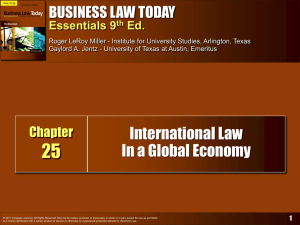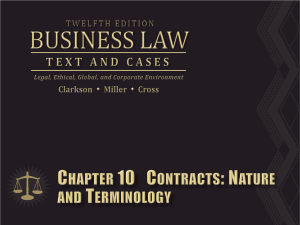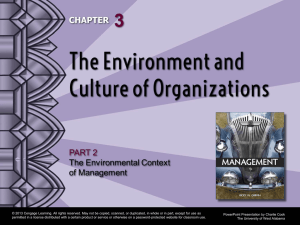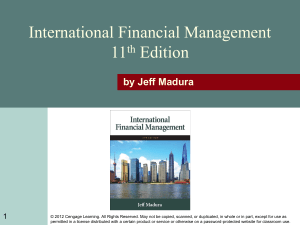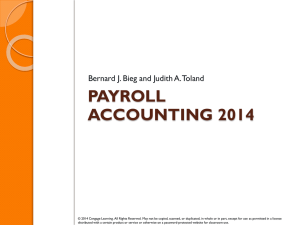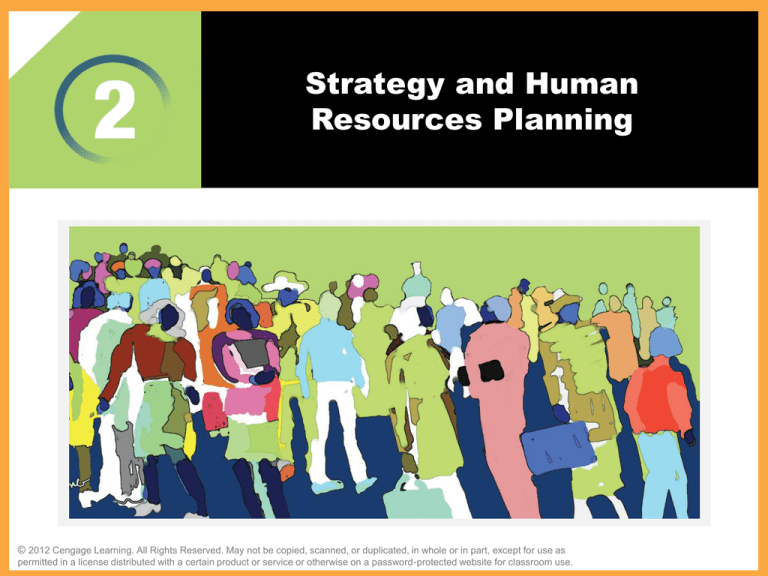
Strategy and Human
Resources Planning
The Challenges of Human Resources Management
© 2012 Cengage Learning. All Rights Reserved. May not be copied, scanned, or duplicated, in whole or in part, except for use as
permitted in a license distributed with a certain product or service or otherwise on a password-protected website for classroom use.
1–1
Chapter Objectives
After studying this chapter, you should be able to
LEARNING OUTCOME 1
LEARNING OUTCOME 2
LEARNING OUTCOME 3
Identify the advantages of integrating human resources planning
and strategic planning.
Understand how an organization’s competitive environment
influences its strategic planning.
Understand why it is important for an organization to do an
internal resource analysis.
LEARNING OUTCOME 4
Describe the basic tools used for human resources forecasting.
LEARNING OUTCOME 5
Explain the linkages between competitive strategies and HR.
LEARNING OUTCOME 6
Understand what is required for a firm to successfully implement a
strategy.
LEARNING OUTCOME 7
Recognize the methods for assessing and measuring the
effectiveness of a firm’s strategy.
© 2012
Learning.
All Rights
Reserved.
May not
be not
copied,
scanned,scanned,
or duplicated,
in whole or in
in whole
part, except
useexcept
as
©
2012Cengage
Cengage
Learning.
All Rights
Reserved.
May
be copied,
or duplicated,
or in for
part,
for use as
permitted
distributed
withwith
a certain
product
or service
or otherwise
on a password-protected
website for classroom
use.
permittedinina alicense
license
distributed
a certain
product
or service
or otherwise
on a password-protected
website for
classroom use.
2 of 36
Strategic Planning and Human Resources
• Strategic Planning
Procedures for making decisions about the
organization’s long-term goals and strategies
• Human Resources Planning (HRP)
Process of anticipating and making provision for the
movement (flow) of people into, within, and out of an
organization.
© 2012
Learning.
All Rights
Reserved.
May not
be not
copied,
scanned,scanned,
or duplicated,
in whole or in
in whole
part, except
useexcept
as
©
2012Cengage
Cengage
Learning.
All Rights
Reserved.
May
be copied,
or duplicated,
or in for
part,
for use as
permitted
distributed
withwith
a certain
product
or service
or otherwise
on a password-protected
website for classroom
use.
permittedinina alicense
license
distributed
a certain
product
or service
or otherwise
on a password-protected
website for
classroom use.
3 of 36
Strategic Planning and HR Planning
• Strategic Human Resources Management (SHRM)
The pattern of human resources deployments and
activities that enable an organization to achieve its
strategic goals
– Strategy formulation —providing input as to what is
possible given the types and numbers of people
available.
– Strategy implementation —making primary resource
allocation decisions about structure, processes, and
human resources.
© 2012
Learning.
All Rights
Reserved.
May not
be not
copied,
scanned,scanned,
or duplicated,
in whole or in
in whole
part, except
useexcept
as
©
2012Cengage
Cengage
Learning.
All Rights
Reserved.
May
be copied,
or duplicated,
or in for
part,
for use as
permitted
distributed
withwith
a certain
product
or service
or otherwise
on a password-protected
website for classroom
use.
permittedinina alicense
license
distributed
a certain
product
or service
or otherwise
on a password-protected
website for
classroom use.
1–4
4 of 36
Step One: Mission, Vision, and Values
• Mission
The basic purpose of the organization as well as its
scope of operations
• Strategic Vision
A statement about where the company is going and
what it can become in the future; clarifies the longterm direction of the company and its strategic intent
• Core Values
The strong and enduring beliefs and principles that the
company uses as a foundation for its decisions
© 2012
Learning.
All Rights
Reserved.
May not
be not
copied,
scanned,scanned,
or duplicated,
in whole or in
in whole
part, except
useexcept
as
©
2012Cengage
Cengage
Learning.
All Rights
Reserved.
May
be copied,
or duplicated,
or in for
part,
for use as
permitted
distributed
withwith
a certain
product
or service
or otherwise
on a password-protected
website for classroom
use.
permittedinina alicense
license
distributed
a certain
product
or service
or otherwise
on a password-protected
website for
classroom use.
1–5
5 of 36
© 2012
Learning.
All Rights
Reserved.
May not
be not
copied,
scanned,scanned,
or duplicated,
in whole or in
in whole
part, except
useexcept
as
©
2012Cengage
Cengage
Learning.
All Rights
Reserved.
May
be copied,
or duplicated,
or in for
part,
for use as
permitted
distributed
withwith
a certain
product
or service
or otherwise
on a password-protected
website for classroom
use.
permittedinina alicense
license
distributed
a certain
product
or service
or otherwise
on a password-protected
website for
classroom use.
1–6
6 of 36
Linking Strategic Planning and HRP
• Strategic Analysis
What human resources are needed and what are
available?
• Strategic Formulation
What is required and necessary in support of human
resources?
• Strategic Implementation
How will the human resources be allocated?
Human Resources
Planning
Strategic
Planning
© 2012
Learning.
All Rights
Reserved.
May not
be not
copied,
scanned,scanned,
or duplicated,
in whole or in
in whole
part, except
useexcept
as
©
2012Cengage
Cengage
Learning.
All Rights
Reserved.
May
be copied,
or duplicated,
or in for
part,
for use as
permitted
distributed
withwith
a certain
product
or service
or otherwise
on a password-protected
website for classroom
use.
permittedinina alicense
license
distributed
a certain
product
or service
or otherwise
on a password-protected
website for
classroom use.
1–7
7 of 36
Step Two: Environmental Analysis
• Environmental Scanning
The systematic monitoring of the major external
forces influencing the organization.
– Economic factors: general, regional, and global conditions
– Industry and competitive trends: new processes, services,
and innovations
– Technological changes: robotics and office automation
– Government and legislative issues: laws and
administrative rulings
– Social concerns: child care and educational priorities
– Demographic and labor market trends: age, composition,
literacy, and immigration
© 2012
Learning.
All Rights
Reserved.
May not
be not
copied,
scanned,scanned,
or duplicated,
in whole or in
in whole
part, except
useexcept
as
©
2012Cengage
Cengage
Learning.
All Rights
Reserved.
May
be copied,
or duplicated,
or in for
part,
for use as
permitted
distributed
withwith
a certain
product
or service
or otherwise
on a password-protected
website for classroom
use.
permittedinina alicense
license
distributed
a certain
product
or service
or otherwise
on a password-protected
website for
classroom use.
1–8
8 of 36
Step Two: Environmental Analysis (Cont.)
© 2012
Learning.
All Rights
Reserved.
May not
be not
copied,
scanned,scanned,
or duplicated,
in whole or in
in whole
part, except
useexcept
as
©
2012Cengage
Cengage
Learning.
All Rights
Reserved.
May
be copied,
or duplicated,
or in for
part,
for use as
permitted
distributed
withwith
a certain
product
or service
or otherwise
on a password-protected
website for classroom
use.
permittedinina alicense
license
distributed
a certain
product
or service
or otherwise
on a password-protected
website for
classroom use.
1–9
9 of 36
Step Two: Environmental Analysis (Cont.)
Culture
Capabilities
Internal
Analysis
Composition
© 2012
Learning.
All Rights
Reserved.
May not
be not
copied,
scanned,scanned,
or duplicated,
in whole or in
in whole
part, except
useexcept
as
©
2012Cengage
Cengage
Learning.
All Rights
Reserved.
May
be copied,
or duplicated,
or in for
part,
for use as
permitted
distributed
withwith
a certain
product
or service
or otherwise
on a password-protected
website for classroom
use.
permittedinina alicense
license
distributed
a certain
product
or service
or otherwise
on a password-protected
website for
classroom use.
1–10
10 of 36
Step Two: Environmental Analysis (Cont.)
© 2012
Learning.
All Rights
Reserved.
May not
be not
copied,
scanned,scanned,
or duplicated,
in whole or in
in whole
part, except
useexcept
as
©
2012Cengage
Cengage
Learning.
All Rights
Reserved.
May
be copied,
or duplicated,
or in for
part,
for use as
permitted
distributed
withwith
a certain
product
or service
or otherwise
on a password-protected
website for classroom
use.
permittedinina alicense
license
distributed
a certain
product
or service
or otherwise
on a password-protected
website for
classroom use.
1–11
11 of 36
Corporate Culture: Values, Assumptions,
Beliefs, and Expectations (VABEs)
• Cultural Audits
Audits of the culture and quality of work life
in an organization.
– How do employees spend their time?
– How do they interact with each other?
– Are employees empowered?
– What is the predominant leadership style
of managers?
– How do employees advance within
the organization?
© 2012
Learning.
All Rights
Reserved.
May not
be not
copied,
scanned,scanned,
or duplicated,
in whole or in
in whole
part, except
useexcept
as
©
2012Cengage
Cengage
Learning.
All Rights
Reserved.
May
be copied,
or duplicated,
or in for
part,
for use as
permitted
distributed
withwith
a certain
product
or service
or otherwise
on a password-protected
website for classroom
use.
permittedinina alicense
license
distributed
a certain
product
or service
or otherwise
on a password-protected
website for
classroom use.
1–12
12 of 36
Forecasting: A Critical Element of Planning
• Forecasting involves:
forecasting the demand for labor
forecasting the supply of labor
balancing supply and demand considerations.
© 2012
Learning.
All Rights
Reserved.
May not
be not
copied,
scanned,scanned,
or duplicated,
in whole or in
in whole
part, except
useexcept
as
©
2012Cengage
Cengage
Learning.
All Rights
Reserved.
May
be copied,
or duplicated,
or in for
part,
for use as
permitted
distributed
withwith
a certain
product
or service
or otherwise
on a password-protected
website for classroom
use.
permittedinina alicense
license
distributed
a certain
product
or service
or otherwise
on a password-protected
website for
classroom use.
1–13
13 of 36
© 2012
Learning.
All Rights
Reserved.
May not
be not
copied,
scanned,scanned,
or duplicated,
in whole or in
in whole
part, except
useexcept
as
©
2012Cengage
Cengage
Learning.
All Rights
Reserved.
May
be copied,
or duplicated,
or in for
part,
for use as
permitted
distributed
withwith
a certain
product
or service
or otherwise
on a password-protected
website for classroom
use.
permittedinina alicense
license
distributed
a certain
product
or service
or otherwise
on a password-protected
website for
classroom use.
1–14
14 of 36
Forecasting Demand for Employees
Quantitative Methods
Forecasting Demand
Qualitative Methods
© 2012
Learning.
All Rights
Reserved.
May not
be not
copied,
scanned,scanned,
or duplicated,
in whole or in
in whole
part, except
useexcept
as
©
2012Cengage
Cengage
Learning.
All Rights
Reserved.
May
be copied,
or duplicated,
or in for
part,
for use as
permitted
distributed
withwith
a certain
product
or service
or otherwise
on a password-protected
website for classroom
use.
permittedinina alicense
license
distributed
a certain
product
or service
or otherwise
on a password-protected
website for
classroom use.
1–15
15 of 36
Quantitative Approach: Trend Analysis
• Forecasting labor demand based on an
organizational index such as sales:
Select a business factor that best predicts human
resources needs.
Plot the business factor in relation to the number of
employees to determine the labor productivity ratio.
Compute the productivity ratio for the past five years.
Calculate human resources demand by multiplying
the business factor by the productivity ratio.
Project human resources demand out to the
target year(s).
© 2012
Learning.
All Rights
Reserved.
May not
be not
copied,
scanned,scanned,
or duplicated,
in whole or in
in whole
part, except
useexcept
as
©
2012Cengage
Cengage
Learning.
All Rights
Reserved.
May
be copied,
or duplicated,
or in for
part,
for use as
permitted
distributed
withwith
a certain
product
or service
or otherwise
on a password-protected
website for classroom
use.
permittedinina alicense
license
distributed
a certain
product
or service
or otherwise
on a password-protected
website for
classroom use.
1–16
16 of 36
Forecasting Demand for Employees
© 2012
Learning.
All Rights
Reserved.
May not
be not
copied,
scanned,scanned,
or duplicated,
in whole or in
in whole
part, except
useexcept
as
©
2012Cengage
Cengage
Learning.
All Rights
Reserved.
May
be copied,
or duplicated,
or in for
part,
for use as
permitted
distributed
withwith
a certain
product
or service
or otherwise
on a password-protected
website for classroom
use.
permittedinina alicense
license
distributed
a certain
product
or service
or otherwise
on a password-protected
website for
classroom use.
1–17
17 of 36
Forecasting the Supply of Employees:
Internal Labor Supply
• Staffing Tables
• Markov Analysis
• Skill Inventories
• Replacement Charts
• Succession Planning
© 2012
Learning.
All Rights
Reserved.
May not
be not
copied,
scanned,scanned,
or duplicated,
in whole or in
in whole
part, except
useexcept
as
©
2012Cengage
Cengage
Learning.
All Rights
Reserved.
May
be copied,
or duplicated,
or in for
part,
for use as
permitted
distributed
withwith
a certain
product
or service
or otherwise
on a password-protected
website for classroom
use.
permittedinina alicense
license
distributed
a certain
product
or service
or otherwise
on a password-protected
website for
classroom use.
1–18
18 of 36
Forecasting the Supply of Employees:
Internal Labor Supply
© 2012
Learning.
All Rights
Reserved.
May not
be not
copied,
scanned,scanned,
or duplicated,
in whole or in
in whole
part, except
useexcept
as
©
2012Cengage
Cengage
Learning.
All Rights
Reserved.
May
be copied,
or duplicated,
or in for
part,
for use as
permitted
distributed
withwith
a certain
product
or service
or otherwise
on a password-protected
website for classroom
use.
permittedinina alicense
license
distributed
a certain
product
or service
or otherwise
on a password-protected
website for
classroom use.
1–19
19 of 36
Internal Demand Forecasting Tools
• Skill Inventories
Files of personnel education, experience, interests,
skills, etc., that allow managers to quickly match job
openings with employee backgrounds.
• Replacement Charts
Listings of current jobholders and persons who are
potential replacements if an opening occurs.
• Succession Planning
The process of identifying, developing, and tracking
key individuals for executive positions.
© 2012
Learning.
All Rights
Reserved.
May not
be not
copied,
scanned,scanned,
or duplicated,
in whole or in
in whole
part, except
useexcept
as
©
2012Cengage
Cengage
Learning.
All Rights
Reserved.
May
be copied,
or duplicated,
or in for
part,
for use as
permitted
distributed
withwith
a certain
product
or service
or otherwise
on a password-protected
website for classroom
use.
permittedinina alicense
license
distributed
a certain
product
or service
or otherwise
on a password-protected
website for
classroom use.
1–20
20 of 36
© 2012
Learning.
All Rights
Reserved.
May not
be not
copied,
scanned,scanned,
or duplicated,
in whole or in
in whole
part, except
useexcept
as
©
2012Cengage
Cengage
Learning.
All Rights
Reserved.
May
be copied,
or duplicated,
or in for
part,
for use as
permitted
distributed
withwith
a certain
product
or service
or otherwise
on a password-protected
website for classroom
use.
permittedinina alicense
license
distributed
a certain
product
or service
or otherwise
on a password-protected
website for
classroom use.
1–21
21 of 36
Step Four: Formulating Strategy
• Strategy Formulation
Moving from simple analysis to devising a coherent
course of action.
• SWOT analysis
A comparison of strengths, weaknesses, opportunities,
and threats for strategy formulation purposes.
Use the strengths of the organization to capitalize on
opportunities, counteract threats, and alleviate internal
weaknesses.
© 2012
Learning.
All Rights
Reserved.
May not
be not
copied,
scanned,scanned,
or duplicated,
in whole or in
in whole
part, except
useexcept
as
©
2012Cengage
Cengage
Learning.
All Rights
Reserved.
May
be copied,
or duplicated,
or in for
part,
for use as
permitted
distributed
withwith
a certain
product
or service
or otherwise
on a password-protected
website for classroom
use.
permittedinina alicense
license
distributed
a certain
product
or service
or otherwise
on a password-protected
website for
classroom use.
1–22
22 of 36
Step Four: Formulating Strategy
© 2012
Learning.
All Rights
Reserved.
May not
be not
copied,
scanned,scanned,
or duplicated,
in whole or in
in whole
part, except
useexcept
as
©
2012Cengage
Cengage
Learning.
All Rights
Reserved.
May
be copied,
or duplicated,
or in for
part,
for use as
permitted
distributed
withwith
a certain
product
or service
or otherwise
on a password-protected
website for classroom
use.
permittedinina alicense
license
distributed
a certain
product
or service
or otherwise
on a password-protected
website for
classroom use.
1–23
23 of 36
Step Four: Formulating Strategy
Growth and
Diversification
Mergers and
Acquisitions
Corporate
Strategy
Strategic Alliances
and Joint Ventures
© 2012
Learning.
All Rights
Reserved.
May not
be not
copied,
scanned,scanned,
or duplicated,
in whole or in
in whole
part, except
useexcept
as
©
2012Cengage
Cengage
Learning.
All Rights
Reserved.
May
be copied,
or duplicated,
or in for
part,
for use as
permitted
distributed
withwith
a certain
product
or service
or otherwise
on a password-protected
website for classroom
use.
permittedinina alicense
license
distributed
a certain
product
or service
or otherwise
on a password-protected
website for
classroom use.
1–24
24 of 36
Business Strategy
• Value Creation
What the firm adds to a product or service by virtue of
making it; the amount of benefits provided by the product
or service once the costs of making it are subtracted
(value = benefits - costs).
Low-cost strategy: competing on productivity
and efficiency
– Keeping costs low to offer an attractive price to customers
(relative to competitors).
Differentiation strategy: compete on added value
– Involves providing something unique and distinctive to
customers that they value.
© 2012
Learning.
All Rights
Reserved.
May not
be not
copied,
scanned,scanned,
or duplicated,
in whole or in
in whole
part, except
useexcept
as
©
2012Cengage
Cengage
Learning.
All Rights
Reserved.
May
be copied,
or duplicated,
or in for
part,
for use as
permitted
distributed
withwith
a certain
product
or service
or otherwise
on a password-protected
website for classroom
use.
permittedinina alicense
license
distributed
a certain
product
or service
or otherwise
on a password-protected
website for
classroom use.
1–25
25 of 36
Business Strategy (cont’d)
• Functional Strategy: Ensuring Alignment
External Fit/Alignment
– Focuses on the connection between the business
objectives and the major initiatives in HR.
Internal Fit/Alignment
– Aligning HR practices with one another to establish
a configuration that is mutually reinforcing.
© 2012
Learning.
All Rights
Reserved.
May not
be not
copied,
scanned,scanned,
or duplicated,
in whole or in
in whole
part, except
useexcept
as
©
2012Cengage
Cengage
Learning.
All Rights
Reserved.
May
be copied,
or duplicated,
or in for
part,
for use as
permitted
distributed
withwith
a certain
product
or service
or otherwise
on a password-protected
website for classroom
use.
permittedinina alicense
license
distributed
a certain
product
or service
or otherwise
on a password-protected
website for
classroom use.
1–26
26 of 36
Step Five: Strategy Implementation
• Taking Action: Reconciling Supply and Demand
Balancing demand and supply considerations
– Forecasting business activities (trends)
– Locating applicants
Organizational downsizing, outsourcing, offshoring
– Reducing “headcount”
Making layoff decisions
– Seniority or performance?
– Labor agreements
© 2012
Learning.
All Rights
Reserved.
May not
be not
copied,
scanned,scanned,
or duplicated,
in whole or in
in whole
part, except
useexcept
as
©
2012Cengage
Cengage
Learning.
All Rights
Reserved.
May
be copied,
or duplicated,
or in for
part,
for use as
permitted
distributed
withwith
a certain
product
or service
or otherwise
on a password-protected
website for classroom
use.
permittedinina alicense
license
distributed
a certain
product
or service
or otherwise
on a password-protected
website for
classroom use.
1–27
27 of 36
Step Five: Strategy Implementation (Cont.)
© 2012
Learning.
All Rights
Reserved.
May not
be not
copied,
scanned,scanned,
or duplicated,
in whole or in
in whole
part, except
useexcept
as
©
2012Cengage
Cengage
Learning.
All Rights
Reserved.
May
be copied,
or duplicated,
or in for
part,
for use as
permitted
distributed
withwith
a certain
product
or service
or otherwise
on a password-protected
website for classroom
use.
permittedinina alicense
license
distributed
a certain
product
or service
or otherwise
on a password-protected
website for
classroom use.
1–28
28 of 36
Step Six: Evaluation and Assessment
• Evaluation and Assessment Issues
Benchmarking: The process of comparing the
organization’s processes and practices with those of
other companies
Human capital metrics
– Assess aspects of the workforce
HR metrics
– Assess the performance of the HR function itself
© 2012
Learning.
All Rights
Reserved.
May not
be not
copied,
scanned,scanned,
or duplicated,
in whole or in
in whole
part, except
useexcept
as
©
2012Cengage
Cengage
Learning.
All Rights
Reserved.
May
be copied,
or duplicated,
or in for
part,
for use as
permitted
distributed
withwith
a certain
product
or service
or otherwise
on a password-protected
website for classroom
use.
permittedinina alicense
license
distributed
a certain
product
or service
or otherwise
on a password-protected
website for
classroom use.
1–29
29 of 36
Step Six: Evaluation and Assessment
© 2012
Learning.
All Rights
Reserved.
May not
be not
copied,
scanned,scanned,
or duplicated,
in whole or in
in whole
part, except
useexcept
as
©
2012Cengage
Cengage
Learning.
All Rights
Reserved.
May
be copied,
or duplicated,
or in for
part,
for use as
permitted
distributed
withwith
a certain
product
or service
or otherwise
on a password-protected
website for classroom
use.
permittedinina alicense
license
distributed
a certain
product
or service
or otherwise
on a password-protected
website for
classroom use.
1–30
30 of 36
Measuring a Firm’s Strategic Alignment
• Strategy Mapping and the Balanced
Scorecard
Balanced Scorecard (BSC)
– A measurement framework that helps managers
translate strategic goals into operational objectives
• financial
• customer
• processes
• learning
© 2012
Learning.
All Rights
Reserved.
May not
be not
copied,
scanned,scanned,
or duplicated,
in whole or in
in whole
part, except
useexcept
as
©
2012Cengage
Cengage
Learning.
All Rights
Reserved.
May
be copied,
or duplicated,
or in for
part,
for use as
permitted
distributed
withwith
a certain
product
or service
or otherwise
on a password-protected
website for classroom
use.
permittedinina alicense
license
distributed
a certain
product
or service
or otherwise
on a password-protected
website for
classroom use.
1–31
31 of 36
Measuring a Firm’s Strategic Alignment
© 2012
Learning.
All Rights
Reserved.
May not
be not
copied,
scanned,scanned,
or duplicated,
in whole or in
in whole
part, except
useexcept
as
©
2012Cengage
Cengage
Learning.
All Rights
Reserved.
May
be copied,
or duplicated,
or in for
part,
for use as
permitted
distributed
withwith
a certain
product
or service
or otherwise
on a password-protected
website for classroom
use.
permittedinina alicense
license
distributed
a certain
product
or service
or otherwise
on a password-protected
website for
classroom use.
1–32
32 of 36
Ensuring Strategic Flexibility for the Future
• Organizational Capability
Capacity of the organization to act and change in
pursuit of sustainable competitive advantage.
Coordination flexibility
– The ability to rapidly reallocate resources to new or
changing needs.
Resource flexibility
– Having human resources who can do many different
things in different ways.
© 2012
Learning.
All Rights
Reserved.
May not
be not
copied,
scanned,scanned,
or duplicated,
in whole or in
in whole
part, except
useexcept
as
©
2012Cengage
Cengage
Learning.
All Rights
Reserved.
May
be copied,
or duplicated,
or in for
part,
for use as
permitted
distributed
withwith
a certain
product
or service
or otherwise
on a password-protected
website for classroom
use.
permittedinina alicense
license
distributed
a certain
product
or service
or otherwise
on a password-protected
website for
classroom use.
1–33
33 of 36
Measuring a Firm’s Strategic Alignment
© 2012
Learning.
All Rights
Reserved.
May not
be not
copied,
scanned,scanned,
or duplicated,
in whole or in
in whole
part, except
useexcept
as
©
2012Cengage
Cengage
Learning.
All Rights
Reserved.
May
be copied,
or duplicated,
or in for
part,
for use as
permitted
distributed
withwith
a certain
product
or service
or otherwise
on a password-protected
website for classroom
use.
permittedinina alicense
license
distributed
a certain
product
or service
or otherwise
on a password-protected
website for
classroom use.
1–34
34 of 36
Key Terms
Balanced Scorecard (BSC)
benchmarking
core capabilities
core values
cultural audits
environmental scanning
human capital readiness
human resources planning (HRP)
management forecasts
Markov analysis
mission
organizational capability
replacement charts
skill inventories
staffing tables
strategic human resources
management (SHRM)
strategic planning
strategic vision
succession planning
SWOT analysis
trend analysis
value creation
© 2012
Learning.
All Rights
Reserved.
May not
be not
copied,
scanned,scanned,
or duplicated,
in whole or in
in whole
part, except
useexcept
as
©
2012Cengage
Cengage
Learning.
All Rights
Reserved.
May
be copied,
or duplicated,
or in for
part,
for use as
permitted
distributed
withwith
a certain
product
or service
or otherwise
on a password-protected
website for classroom
use.
permittedinina alicense
license
distributed
a certain
product
or service
or otherwise
on a password-protected
website for
classroom use.
1–35
35 of 36
Chapter 2 - Learning Outcomes
Learning Outcome Statements
Related Outcomes from Body of the Text
Identify the advantages of integrating human
resources planning and strategic planning.
Why is HR planning integral to a firm’s strategic planning? As an HR professional,
what do you think you could do to tie the two functions together?
Understand how an organization’s competitive
environment influences its strategic planning.
What external factors in the environment do you think firms are most likely to
overlook when formulating their business strategies? How can an HR manager
help its executive team get a fuller picture of the competitive environment in which
it operates?
Understand why it is important for an
organization to do an internal resource
analysis.
Think back to the discussion in Chapter 1 about the auto-parts makers that had to
look for new business lines when GM, Ford, ad Chrysler sales plummeted in the
last recession. How do you think the auto-parts makers assessed their ability to
enter their new markets? Do you think they looked first at new markets and then
the capabilities of their employees and external partners or vice versa?
4
Describe the basic tools used for human
resources forecasting.
If you are currently employed, ask your manager how your firm goes about
forecasting
5
Explain the linkages between competitive
strategies and HR.
Think about a firm you enjoy doing business with or one you don’t. What
competitive strategy does it pursue? Do you think its employees have the right
skills given the strategy? Do you detect any mismatches?
Understand what is required for a firm to
successfully implement a strategy.
Why is it difficult to translate a firm’s strategy into HR deliverables that actually get
the job done? What part of this endeavor do you think HR managers struggle with
the most?
Recognize the methods for assessing and
measuring the effectiveness of a firm’s
strategy.
Why do some organizations rely more on some HR metrics than others? Think
about the businesses on or near your campus. Which metrics do you think they are
most likely to track?
1
2
3
6
7
© 2012
Learning.
All Rights
Reserved.
May not
be not
copied,
scanned,scanned,
or duplicated,
in whole or in
in whole
part, except
useexcept
as
©
2012Cengage
Cengage
Learning.
All Rights
Reserved.
May
be copied,
or duplicated,
or in for
part,
for use as
permitted
distributed
withwith
a certain
product
or service
or otherwise
on a password-protected
website for classroom
use.
permittedinina alicense
license
distributed
a certain
product
or service
or otherwise
on a password-protected
website for
classroom use.
36 of 36
Calculating employee Turnover
and Absenteeism
© 2012
Learning.
All Rights
Reserved.
May not
be not
copied,
scanned,scanned,
or duplicated,
in whole or in
in whole
part, except
useexcept
as
©
2012Cengage
Cengage
Learning.
All Rights
Reserved.
May
be copied,
or duplicated,
or in for
part,
for use as
permitted
distributed
withwith
a certain
product
or service
or otherwise
on a password-protected
website for classroom
use.
permittedinina alicense
license
distributed
a certain
product
or service
or otherwise
on a password-protected
website for
classroom use.
1–37
37 of 36
Employee Turnover Rates
• Computing Turnover Rates:
The U.S. Department of Labor suggests the following
formula for computing turnover rates:
Thus, if there were 25 separations during a month and the
total number of employees at mid month was 500, the
turnover rate would be:
© 2012
Learning.
All Rights
Reserved.
May not
be not
copied,
scanned,scanned,
or duplicated,
in whole or in
in whole
part, except
useexcept
as
©
2012Cengage
Cengage
Learning.
All Rights
Reserved.
May
be copied,
or duplicated,
or in for
part,
for use as
permitted
distributed
withwith
a certain
product
or service
or otherwise
on a password-protected
website for classroom
use.
permittedinina alicense
license
distributed
a certain
product
or service
or otherwise
on a password-protected
website for
classroom use.
1–38
38 of 36
Employee Turnover Rates (cont’d)
• Computing Turnover Rates (cont’d):
Another method of computing the turnover rate is one that reflects
only the avoidable separations (S). This rate is computed by
subtracting unavoidable separations (US) from all separations.
The formula for this method is as follows:
where M represents the total number of employees at mid month.
For example, if there were 25 separations during a month, 5 of
which were US, and the total number of employees at mid month
(M) was 500, the turnover rate would be:
© 2012
Learning.
All Rights
Reserved.
May not
be not
copied,
scanned,scanned,
or duplicated,
in whole or in
in whole
part, except
useexcept
as
©
2012Cengage
Cengage
Learning.
All Rights
Reserved.
May
be copied,
or duplicated,
or in for
part,
for use as
permitted
distributed
withwith
a certain
product
or service
or otherwise
on a password-protected
website for classroom
use.
permittedinina alicense
license
distributed
a certain
product
or service
or otherwise
on a password-protected
website for
classroom use.
1–39
39 of 36
Employee Absenteeism Rates
• Computing Absenteeism Rates
© 2012
Learning.
All Rights
Reserved.
May not
be not
copied,
scanned,scanned,
or duplicated,
in whole or in
in whole
part, except
useexcept
as
©
2012Cengage
Cengage
Learning.
All Rights
Reserved.
May
be copied,
or duplicated,
or in for
part,
for use as
permitted
distributed
withwith
a certain
product
or service
or otherwise
on a password-protected
website for classroom
use.
permittedinina alicense
license
distributed
a certain
product
or service
or otherwise
on a password-protected
website for
classroom use.
1–40
40 of 36


